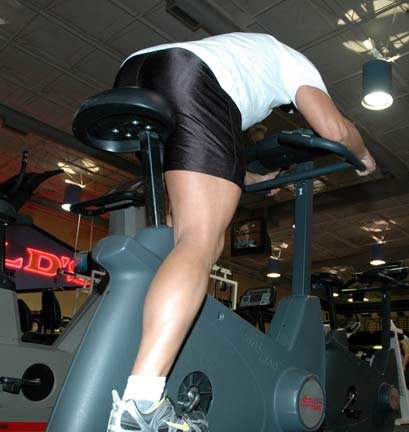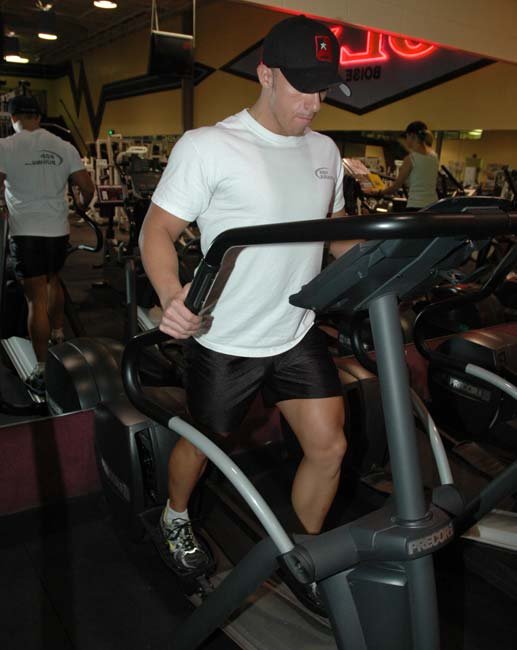I'm sure by now you've seen the case of heart rate monitors at your local sporting goods store and probably considered buying one. Maybe you've even bought one, but don't really know what to do with it. Let's talk a bit about what heart rate training is, why you would want to consider it, and how to go about it.

What Is Heart Rate Training (HRT)?
As you may have guessed, heart rate training is tailoring your workouts and performance based upon your heart rate. Believe it or not, you're already sort of doing this, even if you don't have a heart rate monitor.
When you run at what you consider an easy pace, what does that really mean? Among other things, it means that you run at a heart rate that you consider maintainable for a specified duration.
Looked upon from this perspective, everyone performs heart rate training; some just do it more precisely than others and in a greatly more organized fashion. When people usually talk about HRT, what they mean is training in specific zones utilizing the feedback from a heart rate monitor.

How Do You Monitor Your Heart Rate?
Ever see someone walking around after a run with two fingers held up to the carotid artery taking their pulse? Well, that's one way. I can churn my own butter too, but I'm not Amish so I'll kick it up a notch technologically speaking.
You're realistically going to need a heart rate monitor to get started. Several manufactures make them including Polar, Timex, and Nike. Personally I like Polar because they're compatible with most commercial treadmills, but it's an individual preference.
Your monitor will have 2 pieces, a strap you wear around your chest to capture your heart rate, and a receiver, typically a watch. You can get all kinds of bells and whistles in these things: calories burned, PC synch capabilities, compass, barometric pressure, and whatnot, but all you really need is one that displays your heart rate and the time.
Now that you've got your shiny new watch and chest strap on and feel like a real athlete, that's where the majority of people stop. Let's splash some water on our face and get to understand what the point of all this gear is.
Forum Threads:
- Do Machines Accurately Depict Heart Rate? - Started By crimsonanger
"I guess I just think that if I maintain 90% of my mhr for that long I should feel more tired. Is this too much, or are these machines inaccurate? Can I harm myself doing this?"
- What Is Your Resting Heart Rate? - Started By Pimp-n
"Take it RIGHT NOW. If you're lazy take pulse for 15 seconds and times by 4."
- Heart Rate Watch, Anyone Use it? - Started By toddmclain02
"I'm looking into possibly buying a heart rate watch but its about 120 dollars. Are these worth it?"
In a nutshell, you want to train at different levels of intensity to accomplish different things. You can gauge these levels of intensity using your own feedback and experience (trainers use the fancy term Perceived Level of Exertion), or you can gauge your intensity by monitoring your heart rate. Monitoring your heart rate gives you advantage of precision and eliminates a lot of the subjectivity.
During HRT we call these zones of intensity training. Sometimes we want to keep our heart rate within a certain zone to build aerobic capacity, other times we may want to keep it in a more vigorous zone to build speed. These zones can be calculated using 2 main methods, maximum heart rate and lactate threshold.

1. Maximum Heart Rate:
Most people with even a beginning understanding of heart rate training have heard that to find your maximum heart rate, you subtract your age from 220. This is a nice wild guess like your shoe size is kind of the same distance from your elbow to wrist, but what's the point of getting all geared up with fancy watches if we're not going to be accurate?
The equation itself was uncovered in the 1930's by finding the maximum heart rate of a variety of individuals, some smokers, some trained, some sick, and so forth, and then a line was drawn down the middle to find an average of the general population. Purge that equation from your memory.
The most reliable way to determine your absolute maximum heart rate is to run till you have some kind of health problem, but since that ruins the weekend, we're going to approximate it using a far more accurate method called Lactate Threshold (LT). Put a cool washcloth on your head, this gets more involved than the 220-age estimate.
Click here to calculate your maximum heart rate.

2. Lactate Threshold:
So what's Lactate Threshold? Well, it all has to do with something you may have heard of, lactic acid. During low intensity, your muscles produce lactate and your body absorbs it back, keeping the overall concentration in the blood low.
As your exercise intensity increases however, your muscles produce more lactate than your body can absorb and the concentration in your blood goes up. This point where the body can't keep up with the lactate production is called the lactate threshold and is the highest intensity that a person can maintain for more than about 30 minutes.
The more you train above this point, the greater the imbalance between what your body can absorb and what your muscles are producing and eventually it will cause you to slow or stop.
There's no way to measure your LT from the couch unfortunately, which is why so many people don't know theirs. You've got to go out and suck some wind for awhile to find out what it is. You could, of course, do what the pros do and have blood drawn during your exercise sessions to measure the lactate in your blood, but I'll assume you'll pass on that level of detail.
You also have a different LT for each activity. So you may have a different LT for running than you do cycling. This not only means you have to do the LT test for each sport, but that you'll have different training zones for each sport.
Luckily, the way you perform the test is identical for most endurance sports, or at least for running and cycling, which are far and away where HRT is used the most. It's really not as complicated as it seems and the benefits of this training sure outweigh the minor pain in the neck it is to determine all these zones. I'll try and make it as simple as possible.

Running Or Cycling Is Where HRT Is Used The Most.
For either running or cycling, you're going to perform the same 30 minute time trial.
- Warm up for 15 minutes at and during the last five minutes do a few thirty second sprits to get your heart rate up. When the 30 minutes begins you want to maintain a pace that's as hard as you think you're able to maintain for half an hour.
- After 10 minutes, if you have a heart rate monitor with a 'lap' function, press that lap button to get an average heart rate over the remaining 20 minutes of the test. If you don't have a lap function you'll have to get a reading every minute and do the average yourself.
A treadmill and a training partner are nice to have around in this situation. Remember that you want to end without a whole lot left in the tank, really push yourself.
- That's it! Your LT is the average heart rate over the last 20 minutes.
What Are The Training Zones?
Now that you know your LT, what the heck good does it do you? Nothing, until you figure out your training zones. Then you'll know exactly what HR you should be training at for a variety of goals.
You can see it's easy enough to find what your training zones are. For example, if your LT was 160, your zone 2 would be 136-144 (160 multiplied by .85 and .90).
To build your aerobic capacity, keep your HR in zones 1 or 2.
Zone 3 isn't really low intensity enough to build your aerobic base and not really high intensity to effectively build speed or increase your LT. If you find yourself in this zone, either speed up or slow down depending on your goal to get to zone 2 or 4.
Zone 4 is the sweet spot to increase your LT and gain speed over mid distance events.
To build pure speed in the form of sprints, get to zone 5.

Putting It All Together
If you're at all serious about your training and making gains as efficiently as possible, determining your lactate threshold and using the guidelines above is absolutely essential.
As you bump into other athletes you'll undoubtedly hear many that discount this type of training as unnecessary, citing the fact that many great athletes don't use this as a guide and perform incredibly using only their own senses as feedback.

Determining Your Lactate Threshold
Is Absolutely Essential.
While this is certainly true, the line of thinking is also inherently flawed. There are athletes who eat ice cream and bacon and still perform better than most, but that doesn't make it the best nutritional plan.
Some other gifted athletes have genetics that allow them to train much more haphazardly and still outpace the competition. Others have gotten where they are with years or decades of hard work, sweat, and toil, but perhaps they could have gotten to the same place in far less time using the techniques we've discussed. I could probably drive from New York to Los Angeles navigating using only the sun, but I bet I get there faster using my GPS.
The best resource I've come across for a detailed explanation of the topic is the Triathlete's Training Bible, by Joe Friel and where I gained the vast majority of my own knowledge on the subject.
Don't forget that your LT will change as you become more conditioned so you're going to have to repeat the test periodically to update your training zones. Don't worry, by following the above recommendations you'll be pleased at how quickly you make gains and will start to look forward to the LT tests.
